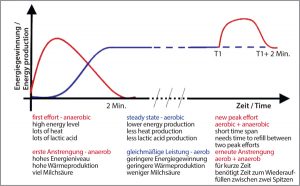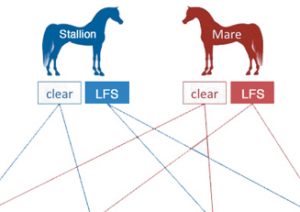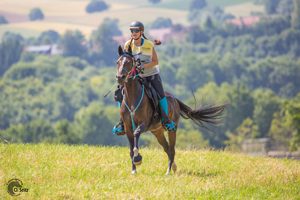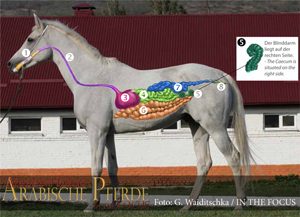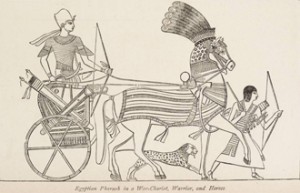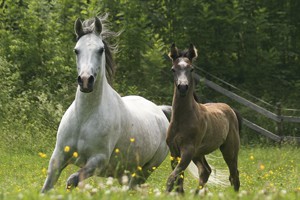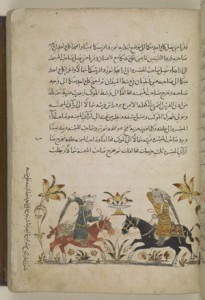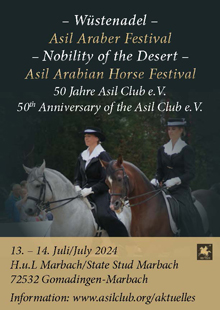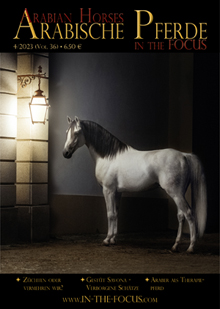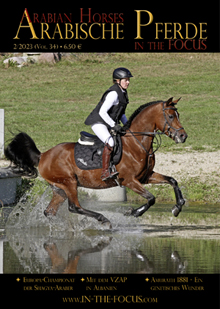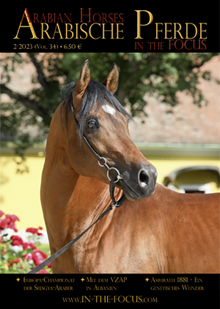Training the Endurance Horse (II) In this part about training the endurance horse, we have a look at the use of the two energy-production systems and how they are provided with fuel and oxygen. In the previous issue we have seen that two different chemical processes contribute to the energy supply of the body: 1) …
Wissenschaft
Oct 07 2017
LFS – Lavender Foal Syndrome
Lavender Foal Syndrome (LFS), also sometimes referred to as Coat Colour Dilution Lethal (CCDL), is an inherited disease specific to Arabian horses. It is caused by a genetic mutation, which is estimated to be present in about 10% of Egyptian Arabians, but has also been reported in other lines of Arabians. LFS-affected foals are unable …
Apr 07 2017
Nutritional Needs of the Endurance Horse
Due to domestication, stabling and riding, we have to feed our horse with an adapted ration of food, to compensate for his decreased grazing time and increased burning of energy. When the horse moves forward for several hours, the repeated muscle contractions require energy provided by the burning of fat. It needs obviously more than …
Jan 10 2017
The Eye of the Owner Feeds the Horse
Feeding the horse athlete is one of the headaches of many endurance rider. Some horses eat too much, others are fuzzy eaters… but all need some individual adaptation of the “standard food plan” to their individual metabolism and requirements by the demanded effort. That’s where “the eye of the owner feeds the horse”. Let’s have …
Aug 02 2016
The Origin of the Arabian Breed
There are several approaches to unearth the origin of the Arabian breed. One of them is through DNA analysis, another is by archaeological findings. Both seem to come to the same result: The Arabian breed originated in what we know today as Syria. Genetic Approach For his dissertation, Dr Khanshour of Texas A&M University analyzed …
Oct 20 2015
(R)evolution of Reproduction
Thanks to modern reproduction technology, we have today a wide range of possibilities of how to bring oocytes (eggcells) and sperms together. But is everything that is technically possible also sensible, desireable and ethically justifiable? The fertility of his breeding stock is an important factor for any breeder not only with regards to breeding as …
Oct 12 2015
Knowledge ensures Safety
The Arabian horse does no more or less than other breeds suffer from genetic defects, but each breed has some specific hereditary diseases, which breeders should know in order to make a responsible breeding plan. In the following article Alban Krösbacher explains the major hereditary diseases in Arabian horses, and those which are predominantely found …
Apr 07 2015
Furusiyah – Die Reitkunst der Mamelucken
Ein Manuskript zur Reitkunst der Mamelucken aus dem 14. Jahrhundert ist in der Qatar Digital Library verfügbar. Achtzehn Zeichnungen illustrieren die Waffen, die von den Reitern benutzt wurden, wie beispielswesie der Bogen, das Schwert und die Lanze. Die Handschrift beschäftigt sich auch mit der Zusammenführung von Truppen und die Bildung von Kampflinien, sowie mit der …
- 1
- 2






